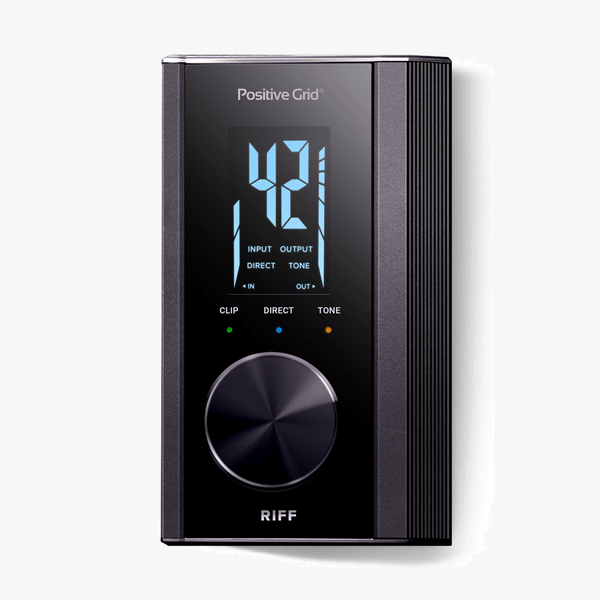Positive Grid’s new RIFF is tiny, even by today’s standards, with plenty of functionality that’s portable with excellent sound quality across the board. We dig it, and so should you – read on…
The anodized aluminum case is smaller than a standard iPhone, with a 1/4” input, and 1/4” output, a headphone jack and a USB connection. Ours was finished in a metallic green, but black, red and other colors are options. A large LCD screen covers overall monitoring and levels, while a large multi-function push knob allows the user to skate through settings and adjust easily.

The RIFF comes in at three pricing levels — the hardware is the same, but the included software varies; we tested our unit out with the higher priced Bias FX 2 Elite software for amp/cabinet/effects emulation. There are standalone and plug-in choices for the Bias FX 2, as well as a mobile version. Connecting it to our Mac Mini was super easy, with no additional software needed. Overall audio quality was excellent with 24bit/96kHz fidelity and no issues with latency. Power to the unit comes through the USB connection, even when using it with an iPad.
Using the RIFF as a typical DAW interface is simple plug and play, the user can run any session using whatever amp sims they prefer; however, the Bias FX 2 does work nicely, with the control knob having a lot of custom assignments for the user’s preference. Even the simple function of using the control knob to scroll through settings was nice, not having to grab a mouse to check out other sounds made workflow a pleasure. The higher cost of the Elite version of Bias FX 2 came with every amp/effect/cabinet/mic option imaginable. Having all these options was quite impressive and offers up tons of possibilities to the player. The emulations are spot on, and quite interactive when placing effects in the signal chain, and the amp models are equally detailed.
This may end up being all you need to track guitar parts from now on.
Running it into an iPad was equally impressive, and with the 1/4” output running into a PA, this could easily be an amp rig for fly-in gigs. Positive Grid also has their own cloud platform allowing players that create sounds on an iPad to transfer them to the plug-in version and vice versa. There have been many times where creating a sound, and not being able to copy that specific tone to a session can be a bummer, especially if it’s something that can really add spice to a track.
This is high quality on-the-go, without cutting corners — it’s a dedicated interface for guitarists that isn’t lacking or overwhelming, with software that sounds great and is easy to work with. The plus side is, even if a player purchases the base model at $99, a separate purchase of the Bias FX 2 Elite is (at the time of this review) just $149. So, for a player who might want to upgrade, it’s no more expensive than buying the version we got right out of the gate.
PROS:
Excellent audio quality, simple to use, great amp and effects choices
CONS:
None
STREET PRICE:
$249 (as tested)
